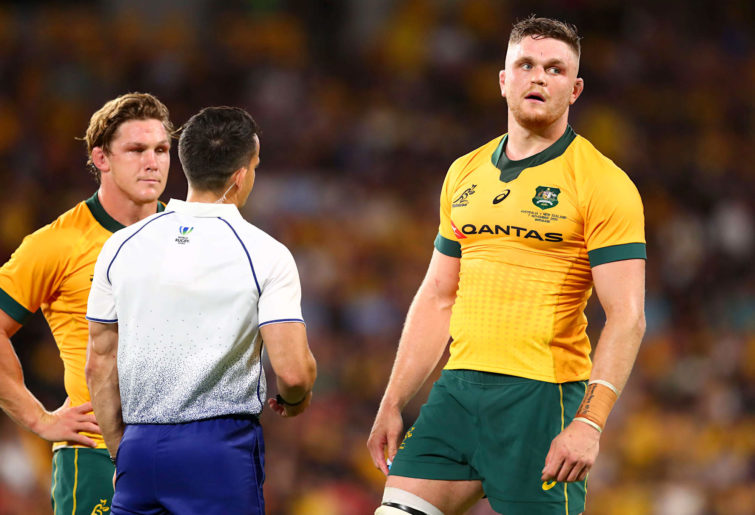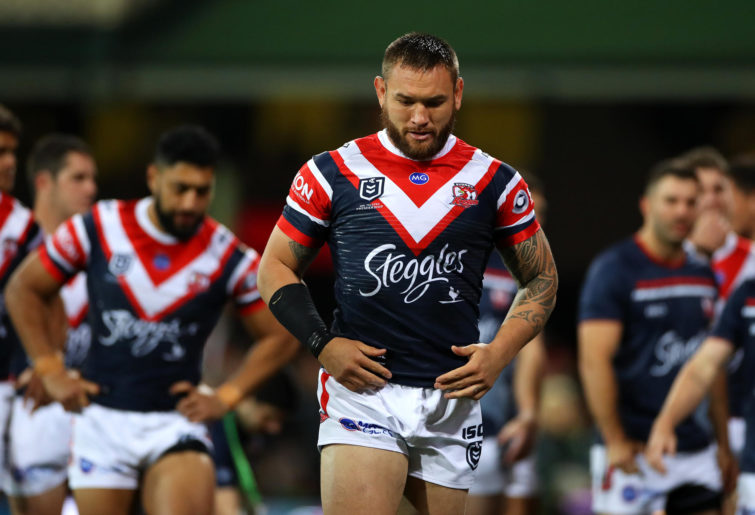In December 2020, Australian Rugby League Commission chairman Peter V’landys announced a raft of law changes designed at improving the flow and spectacle of rugby league. “You’ve got to give the customer what they want,” he said.
The announcement referenced changes made ahead of the 2021 season, with V’landys contending that “It is clear the new innovations last season were a success… the six-again rule has addressed the biggest issue that was in the game and that was the wrestle.”
Maybe it was a figure of speech, or perhaps it is indicative of the closeted bubble that the NRL operates within, but is wrestling really a bigger issue in rugby league than the existential threat that is concussion?
The matter of head injury is a concern for all contact sports. Typically, sports approach the matter from two distinct angles: the treatment and management of affected players; and the design and application of laws and coaching to minimise instances of concussions occurring in the first place.
Complicating the matter is a mounting body of research that suggests a high proportion of player concussions are not one-off major events but an accumulation of seemingly minor occurrences. For example, cases from soccer, attributed to heading footballs over a long period of time, fall into this category.
This has implications for how sporting administrations address things like the amount of contact training that is undertaken, and poses a difficult challenge given the relative ease with which these types of ‘small’ knocks can be picked up.
Notwithstanding, in the two rugby codes and AFL, there are frequent instances of concussions occurring from one-off, high-impact, trauma events.
Both the AFL and rugby union strictly enforce rules concerning high contact. They are prepared to wear the cost of a ‘soft’ penalty or free-kick for an arm slipping over the shoulder as a device to compel tacklers into aiming lower.
Other sports are far tougher than rugby league when it comes to penalising and suspending players for forceful high contact. For example, in eight matches of Super Rugby so far this season, there have been five players sent off and suspended, one for a dangerous tip tackle and four for striking or forceful contact to the head of an opponent.

Red cards are a common sight in rugby union. (Photo by Chris Hyde/Getty Images)
In the NRL, since 2016 – where there have been many more matches and countless more instances of head-high contact – only five players have been sent off in total. Of those, only two involved head contact: Curtis Scott for punching and Chad Townsend for an after-the-whistle, high, flying shoulder-charge.
Neither rugby union nor the AFL are blame-free when it comes to concussion. But their actions (including a new ‘head contact process’ released by World Rugby, and the pending appointment of a head of concussion by the AFL) at least reflect organisations with some understanding of the importance of the issue.
Rugby league, meanwhile, concerns itself with getting rid of the wrestle and tidying up its off-field image, lest it lose sponsors.
In September last year, I examined the NRL’s laws pertaining to high tackles, and the refereeing and judiciary outcomes relating. It made for sobering and concerning reading.
Week after week, multiple players are subjected to head knocks serious enough to warrant head injury assessments (HIAs). Many of these are a result of high contact by a tackling player – illegal under the NRL’s own rules.
For many people in the game, including media and fans, when a player is hit in the head in a high tackle, too often the focus is on any perceived injustice for the offending player, should he be sent to the sin bin or placed on report.

(Photo by Cameron Spencer/Getty Images)
There are multiple risk factors at play for the NRL. Increasing media focus on the dangers of concussion potentially leading parents to prevent their children from taking up rugby league, and more players coming forward with concussion-related medical conditions to sue the NRL, are two obvious ones.
Another potential concern is the sport being subject to penalty under industrial relations laws. There is a growing body of opinion that historic cases such as that of UK footballer Jeff Astle, where a causative link was established between his head trauma and his profession, and Australia’s James Hardie asbestosis case, where a breach of duty of care in an industrial framework was established, means that in a professional sporting context, concussion and its consequential neurological impairments create an industrial disease.
During 2019 and 2020, WorkSafe Victoria conducted no fewer than three investigations into the AFL with respect to concussion. The reports have not been made public, yet the fact the investigations occurred at all, and the AFL acted last month to drastically toughen its return to play protocols from a minimum six days to twelve, points to a degree of concern with respect to potential liability.
Late last year, I contacted SafeWork NSW to inquire if any similar investigations were ongoing, or being contemplated, with respect to concussion in the NRL. A spokesperson provided the following response”
“Work health and safety duties apply in relation to professional sports people for whom sport is work and sport organised by businesses or undertakings. Sports injuries are notifiable only if arising out of the conduct of a business or undertaking for example:
- the way a work activity involving sport is arranged
- the way the sporting activity is managed or controlled
- the condition, design or maintenance of premises or equipment, or
- the way work is carried out, for example inadequate supervision.
“Sports injuries are not notifiable if arising out of the normal conduct of a sports activity for example rough and tumble of a game.”
In other words, no. The statement is worthy of closer examination.
Are the injuries suffered by Billy Slater, Lachlan Lewis, Martin Taupau, Dylan Edwards, Alex Glenn, James Maloney and other victims of high-impact, unlawful headshots in recent seasons examples of the “normal conduct of a sports activity” and the “rough and tumble of a game”?
Further, does the inability of the NRL to ensure that the perpetrators of these and other high, reckless and dangerous tackles face appropriate on and off-field sanction, and the consequent failure to provide an effective deterrent to prevent other players similarly offending, constitute acceptable performance with respect to how the competition is “managed or controlled”?

(Photo by Mark Nolan/Getty Images)
It seems, according to SafeWork NSW, that it does.
I took SafeWork NSW’s response to the NSW government and opposition for comment. Interestingly, the matter was passed through the Minister for Better Regulation and Innovation, Kevin Anderson, to the Acting Minister for Sport, Geoff Lee.
The following questions were posed:
- Do you have any concerns with respect to the NRL and its failure to provide a safe workplace?
- Do you have any concerns with respect to the NRL and its post-concussion return to play protocols?
- Do you have any concerns with respect to the NRL and the way in way in which head contact is effectively and repeatedly sanctioned?
- Will you be seeking advice from SafeWork NSW as to why they are not conducting an investigation, or contemplating conducting an investigation into the NRL over these matters?
From Minister Lee’s office, an Office of Sport spokesperson answered.
“A number of sports such as the Australian Football League, National Rugby League, Rugby Australia and Football Australia have their own individualised concussion policy responses.”
In other words, no to all four questions.
For their part, the NSW opposition raised the matter of concussion in sport at budget estimates on Friday, March 5, directing the following question to a departmental secretary, Rose Webb.
“What day-to-day involvement does SafeWork NSW have with professional sportspeople, given this emerging discussion about concussion?”
After Ms Webb took the question on notice, Shadow Minister John Graham clarified that he was inquiring broadly about professional sports (not just the NRL), and was “just wanting to get a sense of what are the activities in this area”.
So, at least it’s on their radar, but it’s really baby steps from the opposition.
By way of background, SafeWork NSW also informed me that:
“The NSW Government recognises the challenges around head trauma and concussion in community sport. In 2018, the Office of Sport partnered with Sports Medicine Australia (SMA) to release the Concussion in Sport Policy for NSW State Sporting Organisations and State Sport Organisations for people with disability. The NRL Chief Medical Officer assisted in the development of the Policy. The Office of Sport and the SMA are best placed to provide comment on the policy.”
Are we thus to determine that it is the view of SafeWork NSW that because the NSW Government has released a concussion in sport policy, under the advisement of the NRL’s own chief medical officer no less, there is no need to consider the matter of concussion in the NRL any further?
That’s akin to not testing Crown’s suitability to hold a casino licence just because it happened to assist the government in constructing a policy on money laundering.
With SafeWork NSW and NSW’s state politicians adopting a ‘nothing to see here’ position, the matter now rests back with the NRL. Will the 2021 season be business as usual when it comes to forceful head contact to the head, or will there be a change with respect to how the game is refereed on-field and in judiciary outcomes off-field?
On Saturday, the Roosters’ Jared Waerea-Hargreaves was placed on report for making deliberate and forceful contact to an opponent’s head with his elbow. He escaped suspension.

Jared Waerea-Hargreaves. (Photo by Cameron Spencer/Getty Images)
On Sunday, Cronulla’s Jesse Ramien hit an unsuspecting Matt Dufty with a crude, forceful shot to the head. He was cited with a grade-one offence and accepted a three-week ban. If the sport was serious about stamping out unnecessary, impactful contact to the head, would Ramien not have been handed a more severe grading and sanction?
It’s only one round in, but on the evidence so far, nothing has changed.
On February 16, I asked the NRL if they will, for the 2021 season:
- be collating data on the number and outcome of HIA tests conducted in all matches?
- be conducting deeper analysis on the reasons for the HIA tests?
- be collating data on the number and outcome of incidences of concussion at training sessions?
And, if the answer to any of those questions is yes, will the outcomes be made publicly available?
The NRL declined to respond. Once again, nothing to see here.
On Saturday, the Roosters’ Jake Friend – not for the first time in his career – was heavily concussed after a head clash in a tackle. The Roosters now have both of their co-captains, Friend and Boyd Cordner all severely impacted by concussion for this season, while leading player Luke Keary has had issues with head injuries in the past.
Deliberate or accidental, this is more than simple bad luck at play. Something is wrong with the way the game is being played and, by the NRL not confronting the issue publicly, administered.
It will be interesting to see what stance is adopted from here by the mainstream media. The plight of ex-players Shane Tuck, Danny Frawley and Allan Stoneham has ensured that the issue of concussion has dominated media coverage of the AFL off-season in Melbourne.
It defies all logic and common sense for concussion to be a headline issue with respect to football players south of the Murray River but to barely warrant a mention north of it.
Do the Sydney rugby league media genuinely believe that concussion, CTE and early-onset dementia is a regional issue? Or is there implied pressure at work, with respect to not rocking the NRL boat?
The truth is, with respect to concussion, the NRL’s boat is already rocking, even if they and SafeWork NSW don’t yet realise it.
































































































